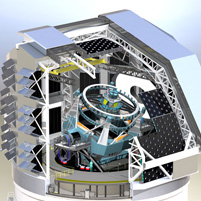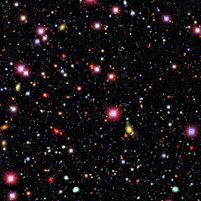Eye on the Sky

Rendering of the LSST dome with a cut away to show the telescope within

Image credit: Deep Lens Survey/UC Davis/NOAO
Imagine a color movie of the sky, where you could see near-Earth asteroids hurtling though space or stars exploding in distant galaxies.
It might sound like something that can only be produced in a Hollywood studio, but scientists from across the U.S., including Carnegie Mellon University, will make it a reality with the Large Synoptic Survey Telescope (LSST).
At the end of August, the National Science Foundation (NSF) signed a cooperative agreement with the Association of Universities for Research in Astronomy (AURA) that allows construction of the telescope to begin. In addition, the Department of Energy has agreed to fund the construction of the telescope's 3.2-billion pixel camera. A consortium made up of U.S. universities and national laboratories hopes to break ground on the telescope's Chilean facility in 2015.
"Carnegie Mellon is proud to participate in the LSST and its science program, which will be at the forefront of cosmology research for the coming decades," said Fred Gilman, dean of the Mellon College of Science and chair of the AURA Council overseeing the LSST's construction.
With what will amount to be the world's largest digital camera, the LSST will — in a single exposure — be able to take an image that covers 49 times the area of the moon. Each night as it takes images of patches of the sky, it will collect 30 terabytes of data. Over the course of 10 years, it will visit each patch of sky an estimated 1,000 times, creating the world's largest astronomical data set.
Hidden within this data will be information about the history of the galaxy and the nature of dark matter and dark energy. The data also will be used to create movies that show activity happening billions of years ago in distant galaxies as well as recent activity in our solar system.
Working with big data such as this is an area where the physicists, statisticians and computer scientists working in Carnegie Mellon's McWilliams Center for Cosmology excel. CMU joined the project in 2008.
Members of Carnegie Mellon's faculty have leadership roles within the project. During his tenure as director of the NSF, CMU President Subra Suresh gave the go-ahead for the LSST's final design phase.
Other participants include:
- Fred Gilman, dean of the Mellon College of Science, is a member of the LSST Corporation's executive board in addition to being the chair of the AURA Council overseeing the LSST's construction.
- Associate Professor of Physics Rachel Mandelbaum is on the project's Science Advisory Committee, and she and Assistant Professor of Physics Shirley Ho are co-leaders of working groups in the LSST Dark Energy Science Collaboration.
- Physics Professors Rupert Croft and Tiziana Di Matteo, and Assistant Professor of Physics Hy Trac will lend their expertise to developing cosmological simulations that will be used to interpret the LSST data.
- Additional faculty from the Physics, Statistics and Computer Science departments, including Computer Science Professor Jeff Schneider and Assistant Professor Barnabas Poczos; and Statistics Professors Christopher Genovese and Larry Wasserman, Associate Professors Ann Lee and Chad Schafer and Project Scientist Peter Freeman, will work together to develop simulation and analysis tools that will extract valuable scientific information from the LSST data.
"The McWilliams Center's multidisciplinary team is ready for the challenge that the LSST data will present," said Gilman. "We will seek answers to many fundamental questions in cosmology, including the nature of dark energy, by using our expertise in physics, computer science and statistics."
Related Links: Mellon College of Science | The McWilliams Center for Cosmology | Large Synoptic Survey Telescope
